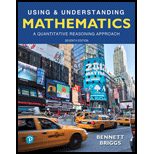
Cells in the Human Body. Estimates of the number of cells in the human body vary over an order of magnitude. Indeed, the precise number varies from one individual to another and depends on whether you count bacterial cells. Here is one way to make an estimate.
a. Assume that an average cell has a diameter of 6 micrometers (6 * 10-6 meter), which means it has a volume of 100 cubic micrometers. How many cells are there in a cubic centimeter?
b. Estimate the number of cells in a liter, using the fact that a cubic centimeter equals a milliliter.
c. Estimate the number of cells in a 70-kilogram (154-pound) person, assuming that the human body is 100% water (actually it is about 60-70% water) and that 1 liter of water weighs 1 kilogram.
Want to see the full answer?
Check out a sample textbook solution
Chapter 3 Solutions
Using & Understanding Mathematics: A Quantitative Reasoning Approach (7th Edition)
- Your employer automatically puts 5 percent of your salary into a 401(k) retirement account each year. The account earns 8% interest. Suppose you just got the job, your starting salary is $40000, and you expect to receive a 2% raise each year. For simplicity, assume that interest earned and your raises are given as nominal rates and compound continuously. Find the value of your retirement account after 30 years Value = $arrow_forwardex 5. important aspects. Graph f(x)=lnx. Be sure to make your graph big enough to easily read (use the space given.) Label all 6 33arrow_forwardSuppose that a room containing 1300 cubic feet of air is originally free of carbon monoxide (CO). Beginning at time t = 0, cigarette smoke containing 4% CO is introduced into the room at a rate of 0.8 cubic feet per minute. The well-circulated smoke and air mixture is allowed to leave the room at the same rate. Let A(t) represent the amount of CO in the room (in cubic feet) after t minutes. (A) Write the DE model for the time rate of change of CO in the room. Also state the initial condition. dA dt A(0) (B) Solve the IVP to find the amount of CO in the room at any time t > 0. A(t) (C) Extended exposure to a CO concentration as low as 0.00012 is harmful to the human body. Find the time at which this concentration is reached. t= minutesarrow_forward
- Newton's Law of Cooling tells us that the rate of change of the temperature of an object is proportional to the temperature difference between the object and its surroundings. This can be modeled by the differential equation dT dt k(TA), where T is the temperature of the object after t units of time have passed, A is the ambient temperature of the object's surroundings, and k is a constant of proportionality. Suppose that a cup of coffee begins at 178 degrees and, after sitting in room temperature of 61 degrees for 12 minutes, the coffee reaches 171 degrees. How long will it take before the coffee reaches 155 degrees? Include at least 2 decimal places in your answer. minutesarrow_forwardDecide whether each limit exists. If a limit exists, estimate its value. 11. (a) lim f(x) x-3 f(x) ↑ 4 3- 2+ (b) lim f(x) x―0 -2 0 X 1234arrow_forwardcan you help me solve this question and show workings pleasearrow_forward
- how could the bar graph have been organized differently to make it easier to compare opinion changes within political partiesarrow_forwardketch a graph of the function f(x) = 3 cos (표) 6. x +1 5 4 3 3 80 9 2+ 1 -9 -8 -7 -6 -5 -4 -3 -2 -1 1 2 3 4 5 6 7 -1 -2 -3+ -4 5 -6+ Clear All Draw: пи > Next Questionarrow_forwardDraw the following graph on the interval πT 5π < x < 2 2 y = 2 sin (2(x+7)) 6. 5. 4 3 3 2 1 +3 /2 -π/3 -π/6 π/6 π/3 π/2 2π/3 5π/6 π 7π/6 4π/3 3π/2 5π/311π/6 2π 13π/67π/3 5π Clear All Draw:arrow_forward
- Let f : X → Y and g : Y → Z be two functions. Prove that(1) if g ◦ f is injective, then f is injective; (2) if g ◦ f is surjective, then g is surjective.arrow_forwardketch a graph of the function f(x) = 3 cos (표) 6. x +1 5 4 3 3 80 9 2+ 1 -9 -8 -7 -6 -5 -4 -3 -2 -1 1 2 3 4 5 6 7 -1 -2 -3+ -4 5 -6+ Clear All Draw: пи > Next Questionarrow_forwardSolve the following boundary value problem using method of separation of variables ди 11.07 (137) 1 J²u + = = 0, -Пarrow_forwardarrow_back_iosSEE MORE QUESTIONSarrow_forward_ios
 Elementary Geometry For College Students, 7eGeometryISBN:9781337614085Author:Alexander, Daniel C.; Koeberlein, Geralyn M.Publisher:Cengage,
Elementary Geometry For College Students, 7eGeometryISBN:9781337614085Author:Alexander, Daniel C.; Koeberlein, Geralyn M.Publisher:Cengage,
 Algebra: Structure And Method, Book 1AlgebraISBN:9780395977224Author:Richard G. Brown, Mary P. Dolciani, Robert H. Sorgenfrey, William L. ColePublisher:McDougal Littell
Algebra: Structure And Method, Book 1AlgebraISBN:9780395977224Author:Richard G. Brown, Mary P. Dolciani, Robert H. Sorgenfrey, William L. ColePublisher:McDougal Littell Mathematics For Machine TechnologyAdvanced MathISBN:9781337798310Author:Peterson, John.Publisher:Cengage Learning,
Mathematics For Machine TechnologyAdvanced MathISBN:9781337798310Author:Peterson, John.Publisher:Cengage Learning, Glencoe Algebra 1, Student Edition, 9780079039897...AlgebraISBN:9780079039897Author:CarterPublisher:McGraw HillAlgebra & Trigonometry with Analytic GeometryAlgebraISBN:9781133382119Author:SwokowskiPublisher:Cengage
Glencoe Algebra 1, Student Edition, 9780079039897...AlgebraISBN:9780079039897Author:CarterPublisher:McGraw HillAlgebra & Trigonometry with Analytic GeometryAlgebraISBN:9781133382119Author:SwokowskiPublisher:Cengage





